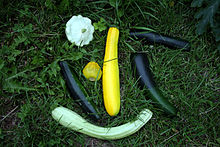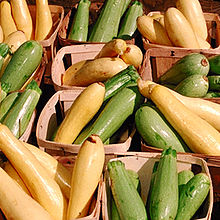zucchini
| zucchini | ||||||||||||
|---|---|---|---|---|---|---|---|---|---|---|---|---|

Zucchini plant |
||||||||||||
| Systematics | ||||||||||||
|
||||||||||||
| Scientific name | ||||||||||||
| Cucurbita pepo subsp. pepo convar. giromontiina | ||||||||||||
The zucchini [ tsuˈkiːni ] ( Cucurbita pepo subsp. Pepo convar. Giromontiina ), in German-speaking Switzerland, zucchetti , is a subspecies of the garden pumpkin and belongs to the cucurbitaceae plant family . Zucchini are monoecious , that is, male and female sexual organs are in separate flowers, but on one plant.
The zucchini is a cultivated form of the garden pumpkin, originally native to America and one of the oldest cultivated plants of mankind . This came to Europe in modern times , where zucchini was bred in Italy . A zucchini was first described in 1856 by the French botanist Charles Victor Naudin .
Description and cultivation
The zucchini plants are similar to those of the vegetable squash, but their leaves are significantly smaller and they are less prone to the formation of tendrils. The zucchini plant has male and female flowers. The males, which do not develop any fruit, can be recognized by the longer stem and the missing ovary directly below the petals. Male flowers may be increased in cool and rainy summers.
There are zucchini with white, yellow, cream-green, dark green and striped fruits. There are elongated and round shapes. If you harvest zucchini 10 to 20 cm long, they make a tender vegetable. If you let them grow, they reach the size of pumpkins, they then sometimes develop a hard shell and pronounced seeds inside. Then they can be stored like pumpkins until well into winter and processed in a similar way. The preferred harvest time is from June to October. The undemanding plants also grow in Central European latitudes. The sowing takes place from mid-April to mid / late May on humus, sufficiently moist soil. For this reason, following a custom that was coined in Italy in the 17th century, the “Zucchini Day” ( giorno dello zucchetto ) is celebrated on May 7th . Each plant needs at least one and a half to two square meters of space. The zucchini seeds take about one to two weeks to germinate .

use
Zucchini can be eaten raw, boiled, grilled, and fried. The very large yellow flower is also suitable for consumption and is considered a delicacy; if only the male flowers are used, the fruit yield is not reduced.
Like other types of pumpkin, zucchini contain a lot of water, are low in calories, rich in vitamins and easy to digest. 100 g zucchini contain on average: 80 kJ, 93 g water, 2.2 g usable carbohydrates, 1.6 g protein, 1.1 g fiber, 152 mg potassium , 30 mg calcium , 25 mg phosphorus , 3 mg sodium , 1, 5 mg iron , vitamins A and C .
Zucchini are usually picked when they are unripe when the fruit is around six to 30 centimeters long and weighs around 100 to 300 grams. They last up to 12 days, but should not be stored below 8 ° C. The zucchini should also not be stored near tomatoes, apples and other climacteric fruits, as the ethylene secreted by them allows zucchini to ripen and spoil quickly. Ripe specimens form a woody tissue under the shell and can weigh 5 kg, can then be kept for several months and are suitable as winter vegetables . Like large pumpkins, they can then be peeled and braised, freed from the core tissue.
Toxicity
Zucchini (dishes) with a bitter taste contain bitter substances ( cucurbitacins ), they must not be consumed and must be disposed of (compost). They are very poisonous and, even in small amounts, cause nausea, vomiting and diarrhea up to life-threatening intestinal damage. The zucchini should always be eaten by tasting the zucchini tip (where the flower was located), where the cucurbitacin content is greatest, and if it is bitter, spit the sample out immediately. The poisonous bitter substances, the cucurbitacins, are not destroyed by cooking and attack the gastric and intestinal mucous membrane after consumption. Especially by back-crossing (home-grown seeds) or crossing with other squash plants, an increased content of Cucurbitacin arise. For example, if gardeners plant zucchini near ornamental pumpkins, pollen can be transferred and backcrossing can be caused. Stressful situations (heat, transport, storage, especially with potted plants) and spontaneous genetic changes can also lead to increased cucurbitacin production. A plant that has recovered can then produce edible fruit again. To avoid any danger, the hobby gardener should definitely use seeds from controlled cultivation, i.e. purchased seeds. In 2015, the death of a man as a result of poisoning after eating a bitter-tasting zucchini casserole was documented.
etymology
The fact that the zucchini is a subspecies of the garden pumpkin is also reflected in the name: In Italian ( [dzukˈkiːni] ) the masculine singularis zucchino or the feminine zucchina are the diminutive of zucca "pumpkin", which means something like "smaller" Pumpkin". The Swiss-German name Zucchetto or Zucchetti (plural) comes from the northern Italian or venedischen dialect and also referred to the diminutive of zucca . A zucchino courgette is French, as is Dutch and English; American however zucchini and Spanish calabacín , Portuguese abobrinha.
The German form zucchini is originally the plural of the Italian zucchino . According to the Duden, the singular in German is the zucchini , more rarely the zucchino . Usually only the plural form is used.
literature
- Alan Davidson: The Oxford Companion to Food . Oxford University Press, Oxford / New York NY 1999, ISBN 0-19-211579-0 .
- Peter Hanelt (Ed.): Mansfeld's Encyclopedia of Agricultural and Horticultural Crops . tape 3 . Springer, Berlin / Heidelberg / New York 2001, ISBN 3-540-41017-1 .
Web links
- Zucchini in the A – Z of the useful plants on the website of the Biological Faculty of the University of Hamburg
- Zucchini at Lebensmittellexikon.de
- Cultivation tips at bio-gaertner.de
Individual evidence
- ↑ Karl Hammer et al .: Pumpkin, Kiwano & Co. - on the benefits of diversity . University of Kassel , 2002. p. 17. Online here (PDF).
- ^ Harry S. Paris: Summer Squash: History, Diversity, and Distribution . In: HortTechnology, Volume 6 (1). American Society for Horticultural Science , 1996. P. 12. Online here (eng, PDF).
- ↑ mature zucchini, autumn 2009
- ↑ For a hazard assessment with references from the literature, see Chemical and Veterinary Investigation Office Stuttgart . accessed July 9, 2019
- ↑ For detailed information with references see forum. Nutrition Today, accessed July 9, 2019
- ^ Zucchini meal: 79 year old died of poisoning . In: Südwestpresse, August 18, 2015; accessed March 17, 2017.
- ^ Tullio de Mauro: Grande dizionario italiano dell'uso , vol. 6, Torino 1999, 1149; Both forms are referred to as comune ("common"), but zucchino is the main entry.
- ↑ Udo Pini : The Gourmet Handbook . 3. Edition. Könemann, Cologne 2000, ISBN 3-8290-1443-0 , p. 1008-1009 .
- ↑ a b Duden editorial team (ed.): Duden. The German spelling. 22nd edition. Dudenverlag, Mannheim / Leipzig / Vienna / Zurich 2000, ISBN 3-411-04012-2 , p. 1099.




